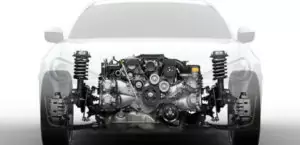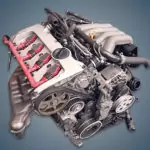The 3.0-liter Audi DLZA 3.0 TFSI engine has been assembled at the German company’s plant since 2018 and installed on the concern’s most massive mid-size models: the A6 and A7 in the C8 body. This unit is part of a hybrid installation with a separate 48-volt network.
The EA839 series includes: CZSE, DLZA, CWGD, DECA.
Specifications
| Production years | since 2018 |
| Displacement, cc | 2995 |
| Fuel system | direct injection |
| Power output, hp | 340 |
| Torque output, Nm | 500 |
| Cylinder block | aluminum V6 |
| Block head | aluminum 24v |
| Cylinder bore, mm | 84.5 |
| Piston stroke, mm | 89 |
| Compression ratio | 11.2 |
| Features | mild hybrid |
| Hydraulic lifters | yes |
| Timing drive | chain |
| Phase regulator | on all shafts |
| Turbocharging | TwinScroll |
| Recommended engine oil | 0W-20 |
| Engine oil capacity, liter | 7.0 |
| Fuel type | petrol |
| Euro standards | EURO 6 |
| Fuel consumption, L/100 km (for Audi A7 2019) — city — highway — combined |
9.2 5.6 6.9 |
| Engine lifespan, km | ~270 000 |
The engine was installed on:
- Audi A6 C8 (4K) since 2018;
- Audi A7 C8 (4K) since 2018.
Disadvantages of the Audi DLZA engine
- Since this turbo engine has recently begun to be installed, there are no statistics on its breakdowns.
- The intake manifold is now combined with the cylinder head and cannot be replaced separately.
- The turbocharger is in the collapse of the cylinder block with the hot side inward.






